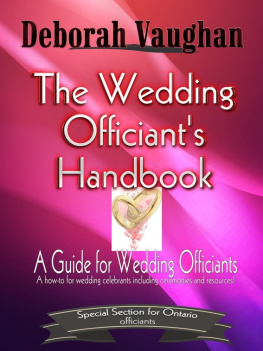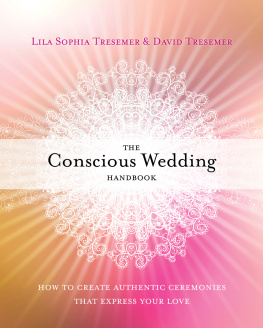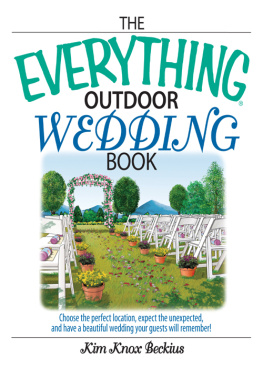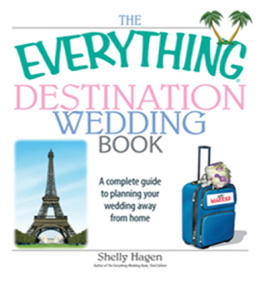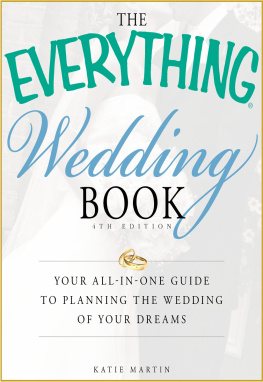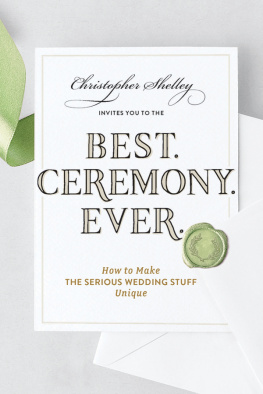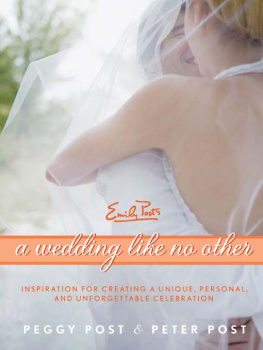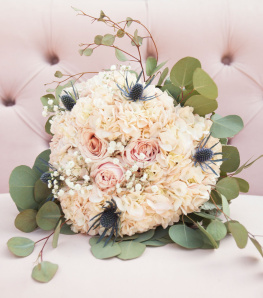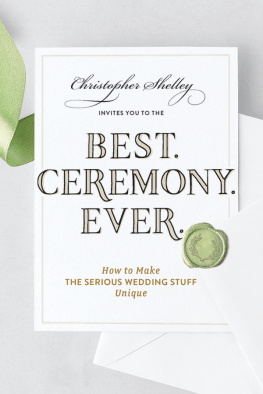The Wedding Officiants Handbook
A Guide for WeddingCelebrants
Special Section for OntarioOfficiants
Deborah L Vaughan
Smashwords Edition
Copyright 2016 Deborah Vaughan
All rights reserved. No part of this book may be reproduced ortransmitted in any form without permission in writing from thepublisher except by a reviewer who may quote brief passages forreview purposes.
Table of Contents
Introduction
Things change. In the past, only Justices ofthe Peace, ordained priests and ministers, and those with specialpermission were permitted to officiate at weddings in Ontario.
More and more, non-religious andwedding-focused organizations are offering certification for thosewho would like to marry people. Many men and women who have been'certified' or 'ordained' have asked for my advice or assistance,expressing a need for more training as they assume the duties of awedding celebrant. Those questions and my own experience form thebasis of this little guide.
So, you have your license to marry people or perhaps you are considering applying to be certified. As webegin, the first question to ask yourself is, Why am I attractedto this line of work?
From the outside, being a wedding celebrantseems like a fun and easy way to earn money. Everyone is having agreat time, you are part of a very special occasion and, well, youjust have to read the script, right? But as many have learned, awedding celebrant bears a great responsibility and duty.
When you agree to officiate at someoneswedding, you are entering into a legal contract. Fulfilling thatcontract is more than just reading a ceremony off a paper andremembering to fill in the correct names. It is the beginning of aconnection that can last for years.
During the planning process, the couple willlook to you to guide them through the myriad of details involvedwith their ceremony. They may be nervous. They will look to you tobe the expert and the trouble-shooter. And, they will expect you toprovide them with a meaningful, once-in-a-lifetime experience onthe most important day of their lives.
This guide will help prepare you to be ajoyful, confident, competent, in-demand celebrant.
You will definitely earn your money, buthopefully, you will find rewards in so many ways that the paymentbecomes secondary. Being a wedding officiant is like no other work.It can be very challenging. It can make your heart soar. It candraw on resources and gifts you never knew you had. At the heart ofit all, this work is all about service, about ministry, aboutcelebrating love in all its fullness.
I have been officiating weddings for 30years, first as an Anglican priest and now as the presiding bishopfor the Community Catholic Church of Canada. I have officiated ateverything from religious ceremonies to handfastings, fromfive-minute civil-type ceremonies to full-blown church weddingswith a communion component. I have been involved in weddings thatwere absolutely perfect and those that were a comedy of errors fainting grooms, forgotten rings, vows exchanged in the pouringrain, brides that had second thoughts. One learns to go with theflow and get very creative when necessary.
I do come at this from a Western, Christianperspective so the history and experience I present comes from thatwindow.
I am also aware that many people reading thismaterial are likely not ordained clergy. For me, marriage is asacrament, an outward sign of the love that shines forth fromwithin the couple and a connection to Divine Love, Godself. Thewedding is certainly a legal contract with promises and apronouncement, signed and witnessed and registered with theprovince, but the marriage and the loving bond that brings peopletogether represents so much more.
Whether you come at this from a religious,spiritual or secular perspective, I know this guide will offerassistance.
As we begin our exploration of the elementsof a wedding, lets look at some historical highlights to gain anoverview of the marriage covenant.
CHAPTER 1
The Celebration of a Marriage
A Bit ofBackground
Throughout the centuries, couples of allcultures, traditions and faiths have held ceremonies to make theircommitment and love for one another "official" in some way.
The word "wed" comes from an Anglo Saxon wordthat literally translates to "a man makes vows to marry a certainwoman." "Wed" is a word that signifies a contract, so the "wedding"is the occasion where the contract is declared in public. Ofcourse, since the dawn of history, the peoples of the world havecalled this intentional union of a couple many names and celebratedit in many ways.
Whether it was a public expression ofpromises, tying ribbons around wrists as a symbol of beingeternally connected to one another (ie. "tying the knot"), jumpingover a broom together or even drinking out of a common cup, thedeclaration of a couple's love for one another has long been causefor great celebration and joy.
The history of the customs and traditions ofmarriage can make for interesting reading and we can still see theremnants of those ancient celebrations in our modern-dayceremonies. Looking into the reasons behind why we do the things acertain way in a ceremony can be very enlightening and bring newunderstanding.
For example, in the middle ages in Europe andthe UK, the custom of having bridesmaids and groomsmen arose from atime in history when the bride was often the subject of akidnapping.
Some stories explain that this was actually afun custom. One of the roles of the attendants in the bridal partywas to arrange a kidnapping and not allow the groom to see thebride until the wedding. Still there were real occasions of dangerand the groomsmen and noble groom would indeed be called upon todefend the bride. So, even today, the groom stands to the bride'sright so that his sword hand is free in case of altercation.
Brides were believed to be lucky. The customof the bride throwing the bouquet was a kind of diversionary tacticto keep the ladies busy so they would not chase after her and tearbits of her dress as talismans. Hence, throwing the bouquet was astrategy for the bride to save herself and the garments she waswearing and make a quick exit to a waiting carriage.
It is also suggested that the wedding bouquetitself, besides being a lovely decorative element, masked bodyodors of everyone involved since access to bathing facilities wasoften limited.
As with many customs handed down fromgeneration to generation, the original meaning or intent can getlost along the way. A little research into the meanings andbackground of things we often take for granted in a ceremony can bereally enlightening and provide some fun information to share withyour couple.
Chapter 2
TheSacrament of Holy Matrimony
Development
It is important for celebrants to understandthe historical perspective of marriage even if you arentreligious -- because the Church has played a major role in shapingthe ceremonies that we have today.
Since the days of the Early Church, theSacrament of Holy Matrimony was viewed as one of the lessersacraments (along with Penance and Extreme Unction) based on Jesus'first public miracle at the wedding in Cana. But through the firstten centuries, the Church had very little to do with blessingcouples at their public declarations.
It is interesting that for those firstcenturies, marriages were seen as a private affair between a couplewithout any clergy present - just family and the community. In manycultures, marriage was a rite of passage with the understandingthat the couple would take their place in the community, build alife together and have children.
Up to the 19th century, marriages were oftenarranged by parents, sometimes from the child's birth. At the timeof the wedding, the bride could be as young as 12 years of age andshe had no say in her parent's choice. The marriage was consideredto be a life-long union. Divorce could be obtained by a judge onlyunder extreme conditions.

